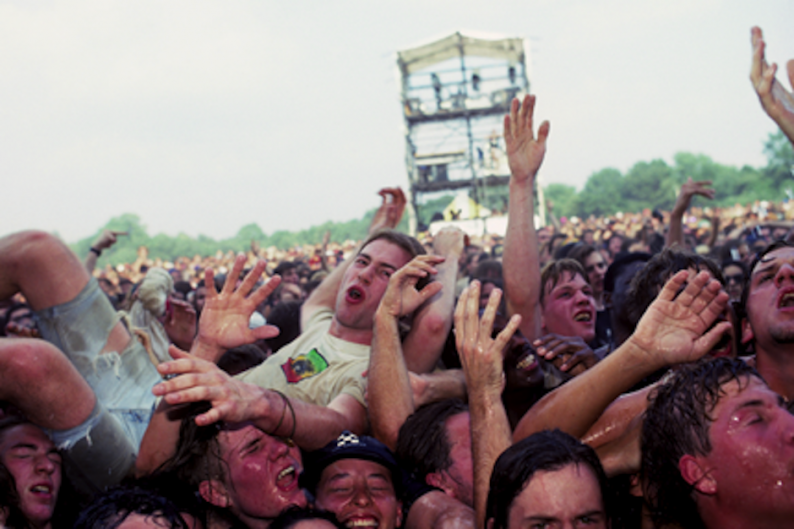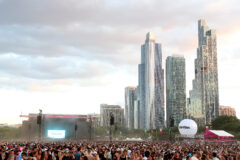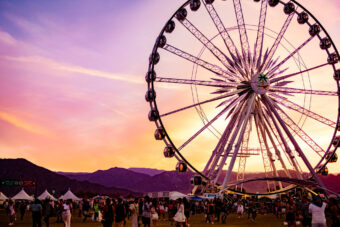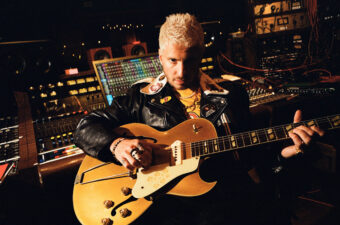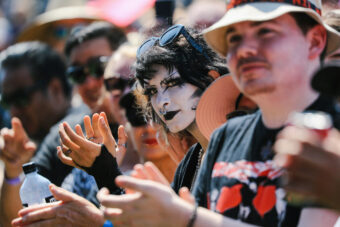On July 18, 1991, the Lollapalooza tour launched in Tempe, Arizona, in appropriately ramshackle fashion.
DANNY ZELISKO (promoter): Compton Terrace in Tempe, which I’d been booking for about seven years, was owned by Jess Nicks and Gene Nicks. Jess is Stevie Nicks’ dad, and Gene is Jess’ brother. Those two and Stevie were the three principals. So, Stevie Nicks presented the first Lollapalooza, in a way.
HAYNES: That place was just a flat, thankless expanse of land. Fucking miserable.
JOBSON: It was so hot you couldn’t even put your hand on the steel the stage was constructed from. And we’re in some rodeo shithole in Arizona. Someone really thought that one out.
ZELISKO: And here come Nine Inch Nails, walking up all in black and chains and safety pins. Pretty dark for the middle of the afternoon in Arizona. And they weren’t into their set more than a minute or two when shit started screwing up onstage. Next thing I know, they’re breaking guitars and knocking over amplifiers and swearing, really pissed off.
JOBSON: You use electronic equipment and you don’t have direct cooling for it and we’re doing a show in 115-degree heat — what’s going to happen?
RICHARD PATRICK (guitarist, Nine Inch Nails): This power cable — a $15 thing called a quad box — kept short-circuiting and would shut everything off. Here we are, first show on the most important tour of our lives, and this whole thing goes down in a nightmare. So we trashed the stage and went on our crazy little punk-industrial rampage and stormed off. Blamed everybody, but it was really just one bad cable.
JOBSON: I remember a fistfight between Perry Farrell and Dave Navarro on the first rehearsal day, which was quite entertaining. Perry’s a tough cat, actually, in a fight. Dave got the short end of it there.
NAVARRO: That took place during the performance. It wasn’t during a rehearsal.
FARRELL: Dave didn’t want to go back on, and I felt that we should’ve given them a longer show. He said he’s not going, and I was like, “You are.” Then I picked him up — in those days, I used to watch pro wrestling — and I gave him a pretty good body slam. We ended up going back on.
NAVARRO: From that point on, everything went smooth. We didn’t necessarily iron anything out, we just got past it.
AVERY: That’s just so…that is Jane’s Addiction right there.
Farrell intended Lollapalooza to blend art and activism, presenting the full spectrum of opposing viewpoints, from the ACLU to the KKK. Things didn’t pan out that way in the festival’s first year, but nascent organizations such as the Surfrider Foundation and Rock the Vote, among others, did gain national exposure.
NAVARRO: Instead of a Budweiser tent and a Nokia tent, it was local artists.
FARRELL: Amok Books was a really progressive bookstore in L.A. Their books were really hedonistic and interesting, so we took them out on the road with us. Because I thought people should read — my people should read.
KEVIN HANLEY (representative, Amok Books): We carried everything from French theory to bomb-making manuals, snuff films to Tom of Finland gay-porn comics. It was pre-Internet; there was no way to get your hands on this stuff.
PATRICK: Kevin handed me the raw, uncut footage of [Pennsylvania politician] R. Budd Dwyer’s suicide, and that’s what inspired the song “Hey Man, Nice Shot.”
HANLEY: From venue to venue, you would figure out what towns had the most reactionary young people. Orlando was very scary. We had kids threatening to beat us up and set fire to the booth.
HENRY ROLLINS: At the end of the day, everyone is on the highway going home, and we had to wait around for the audience to clear so we could get the buses out. And you would see two or three guys, whoever was doing the T-shirts, sitting around very nervously. You’d go, “Hey, how you doing?” and they just wouldn’t talk to you. Then, over this misty, muddy field would come a Brink’s truck. These guys were sitting on top of bags of who knows how many thousands of dollars. They’d throw them in the back of the truck and sign out on some clipboard, and the truck goes away, and it’s no longer these guys’ problem. Immediately, they’d crack open a beer or light a joint and ask how your show was. It was interesting to recognize: Wow, those are bags of money.
PERKINS: It was a train of freaks traveling the world, bringing it to Ohio, bringing it to Jersey, bringing it to Seattle, and seeing that it was everywhere, and they were waiting for it, and they were hungry for it. And once we left the town, the town was never the same.

